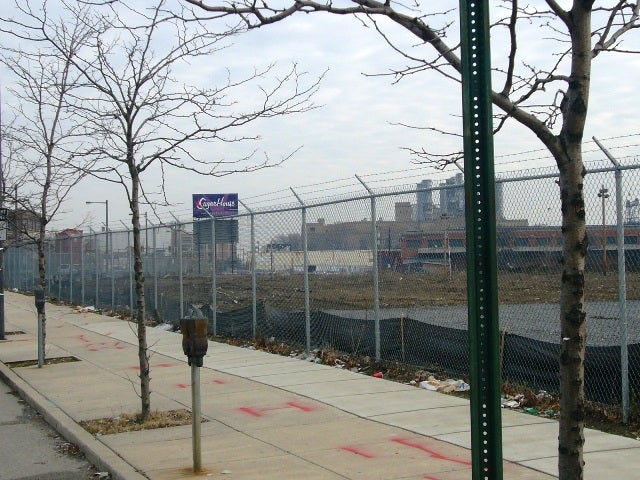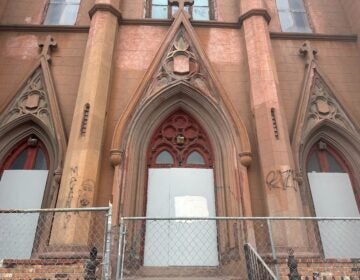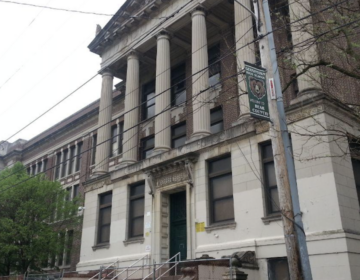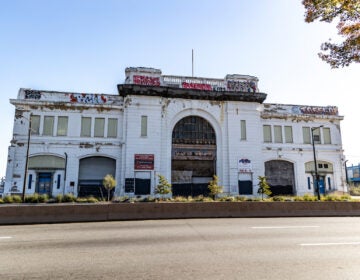SugarHouse to begin preliminary construction

Jan. 05
Check this link for notice of public comment on dig.
Check this link for relevent state and federal historic protection acts.
Previous story
By Kellie Patrick Gates
For PlanPhilly
Armed with permits issued on the last working day of the Street administration, SugarHouse Casino officials plan to start preliminary construction work at the riverfront site early next week.
“We’re zoned, we’ve got the rough grading permit, we’re ready to rock and roll,” spokeswoman Leigh Whitaker said Saturday.
Outgoing Mayor John Street is a casino advocate, while successor Michael Nutter, who will be sworn in Monday morning, is considerably less enthusiastic. Many who do not want a casino built on the riverfront were hoping that a slew of court cases and other delaying factors would mean no permits would be issued before Nutter took office.
The State Supreme Court ruled last month that the SugarHouse site had the needed Commercial Entertainment District zoning without further action from City Council, agreeing with the casino that city officials had unreasonably delayed the process. The DEP stormwater discharge construction permit was officially issued Friday, Whitaker said, followed by the rough grading permit, which allows SugarHouse to dig out the old foundation of the sugar plant and grade the soil surface.
“A lot of people are panicked, but it’s not worth panicking,” said Brian Abernathy, spokesman for Councilman Frank DiCicco, who opposes the proposed casino site.
When asked what City Council’s next step was, Abernathy said he didn’t know, as he had just learned the permit was issued. But “there is still a lot of legal maneuvering going on.”
City Council had asked the State Supreme Court to reconsider its SugarHouse decision, but the court denied that request on New Year’s Eve. “We’re still looking at what options we have to appeal the Supreme Court decision,” Abernathy said.
There is also a Supreme Court case pending against the city and its Commerce Department, which granted SugarHouse the right to build on the Delaware Riverbed. The state lawmakers who filed it argue that only the General Assembly has the power to grant riparian rights.
The grading permit “allows them to tell their investors they’ve stuck a shovel in the ground,” Abernathy said.
SugarHouse cannot begin construction – even foundation work – without acquiring additional permits.
Last month, a Philadelphia Licenses & Inspections permits manager indicated that they could not even get a permit to move dirt without having water and sewer permits first, due to the size of the project. Local water permits are not given for projects requiring a Clean Water Act Permit until that federal permit is issued, and SugarHouse does not yet have its Clean Water Act Permit.
It could not be determined today why the grading permit was issued without the Clean Water Act Permit.
Some local historians and history buffs say it’s no where near time for the Army Corps of Engineers to issue the Clean Water Act Permit, because more time is needed to investigate the past history of the site, where a Revolutionary War Fort once stood.
SugarHouse archaeologists say they searched hard for the remains of a British fort – once they realized it used to be on the proposed casino site – and found nothing.
“We believe that the position of the former fort has been severely impacted several times by 19th and 20th century industrial activities,” A.D. Marble & Company archaeologist Judson Kratzer wrote in a summary report prepared for the Pennsylvania Historical and Museum Commission.
“If any remains could possibly still exist, it would only be the filled in portion of the depression that likely surrounded the Fort. However, the Phase II field work found no evidence of such a feature,” Kratzer wrote. “It is our contention that any remains of any kind would be difficult to interpret without the existence of the overall resource. No further action is recommended within the area of the former Fort.”
This recommendation flummoxed a group of amateur and professional historians who say a more thorough dig is needed to be certain that no artifacts from the lives of the soldiers who occupied Philadelphia remain.
“Huh? You need the ‘overall resource’ (entire fort) to find anything?” Torben Jenk, a builder and preservationist who has researched Kensington and Fishtown history for more than a decade, wrote in an email. “They obviously need someone better skilled at Revolutionary War archaeology.”
SugarHouse could not be reached for comment Saturday. SugarHouse hired Conshohocken-based A.D. Marble to satisfy the requirements of a Clean Water Act Permit, which it needs because it plans to build into the Delaware River. Federal law requires the Army Corps of Engineers to explore the history of the site and make sure efforts are taken to preserve anything important before issuing the permit. Here, this is done with guidance from the Pennsylvania Historical and Museum Commission, which is why the summary report was sent to Douglas McLearen, the Commission’s division chief for archaeology and protection.
Marble did find evidence of Native American activity in one 50-by-30 foot area, which was “intensively investigated,” the report says. Mostly, archeologists found “flakes of jasper, quartz and argillite, probably created during the manufacture or maintenance of stone tools”. They also found “a broad-bladed, stemmed point.” But after analysis, the report says, “It is our opinion that the prehistoric artifact frequency is low” and “we do not believe these remains represent a significant archaeological resource warranting further investigation.”
Jenk does not mind a casino going up on the site, so long as enough time is taken to be sure any historical evidence is saved first. He was disheartened to learn that SugarHouse would soon be starting grading work.
“Depending how deep they go, they could wipe out 90 percent of any archeology worth finding,” he said.
“If SugarHouse found something, and put it on display and interpreted what they found, that’s a whole other reason to get customers in the door,” he said, especially since the Washington-Rochambeau Revolutionary Route passed nearby, and in the future, people who want to walk the Route might also want to stay in the SugarHouse hotel.
“I don’t get this disrespect of history, thinking it’s just a cost and a inconvenience and not looking at it from the other side – this is a resource.”
Marble has recommended a third phase of exploration in some areas of the site where remnants of a neighborhood stretching back to the mid-1700s have been found.
The findings include brick and stone foundation walls and privies and shafts in former backyards. Privies and shafts please archaeologists and historians because people often used them to dump garbage and other unwanted household items that can teach much about past residents, including what they ate, how they cooked, what they wore and what they played with.
Sixteen shaft features found in Historic Area H-1 “were circular in shape and lined with brick” the report states. An oval-shaped cistern, made from a concrete-like substance and lined with mortar, was also found. “A barrel privy, built using buried wooden barrels positioned one above the other, was found in the extreme southern end of Historic Area H-2.”
Six shafts were found to contain historic remains that have not been greatly disturbed. “It should be possible to link these artifacts with particular residential lots and thereby with individual owners or inhabitants of those properties,” A.D. Marble’s Kratzer wrote. Four of the six shafts are believed to contain artifacts from the mid 19th to early 20th century, and two seem to have mid-18th to early-19th century items.
A.D. Marble recommended that these six shafts be fully excavated and their contents be removed following procedures agreed to by the Historical and Museum Commission.
In order to do this, large areas surrounding each shaft first need to be excavated for safety reasons, the report states. The company is now preparing a full Phase II report and a Phase III work plan.
The Corps will also hear recommendations from recently-named consulting parties – interested groups and individuals who asked to take part in the process. Terry McKenna, project executive for SugarHouse’s general contractor, Keating Consulting, emailed a copy of the A.D. Marble report to the consulting parties on Friday evening.
The Corps will take written public comment from anyone, but the consulting parties are kept informed of all developments and will take part in meetings with SugarHouse, the Corps and the Historical and Museum Commission. The first of these meetings, which is not open to the public, is scheduled for Jan. 18, said James Boyer, a biologist with the Corps’ regulatory division.
Whitaker said it would not be appropriate to discuss what SugarHouse will say to the Army Corps, Historical and Museum Commission and consulting parties until after the Jan. 18 meeting.
The full Phase II report is expected to be completed prior to that meeting.
“There’s going to be a request to do further digging, even beyond with the new report recommends,” said John Connors, director of the Penn Treaty Museum.
Hilary Regan, who will represent the Northern Liberties Neighbors Association as a consulting party, said the latest report has not changed her mind that there was an “inadequate amount of research done to guide them where they should be digging.”
She noted that A.D. Marble and SugarHouse did not know the fort had existed when it started the work, even though the fort is shown on many old maps. She also pointed out that the Phase I report indicated no Native American artifacts would likely be discovered, and this report shows that some were found at the sight.
“What we’ve seen in a lot of their research is there’s just gaping holes,” she said.
Regan said she will ask the Army Corp to require more digging, and to seek input from local experts to help hone the scope of the dig.
She also plans to reach out to U.S. Senator Arlen Spector with a request that he get involved.
“This isn’t just Philadelphia history or Northern Liberties history, this is American History, something of national significance,” she said.
Contact Kellie Patrick Gates at kelliespatrick@gmail.com
WHYY is your source for fact-based, in-depth journalism and information. As a nonprofit organization, we rely on financial support from readers like you. Please give today.






